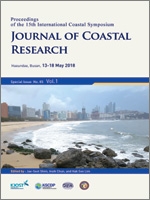Leal Alves, D.C.; Espinoza, J.M.A.; Albuquerque, M.G.; Silva, M.B.; Fontoura, J.S.; Serpa, C., and Weschenfelder, J., 2018. Bathymetry estimation by orbital data of OLI sensor: a case study of the Rio Grande harbor, southern Brazil. In: Shim, J.-S.; Chun, I., and Lim, H.S. (eds.), Proceedings from the International Coastal Symposium (ICS) 2018 (Busan, Republic of Korea). Journal of Coastal Research, Special Issue No. 85, pp. 51–55. Coconut Creek (Florida), ISSN 0749-0208.
In the coastal and estuarine systems, the determination of bathymetric data is an important instrument for a safe shipping in harbor zones. Generally, data are collected in situ or ground, however, this information is time-consuming and costly. Remote sensing can be regarded as one of the most promising alternative tools to map bathymetry of the estuaries and coastal zones, due to its extensive coverage of the area and the low cost imbued. This study aims to analyze the accuracy of bathymetric data obtained by the Operational Land Imager (OLI) sensor, coupled to Landsat 8 orbital platform, in comparison to the results with bathymetric data collected in situ (echo sounder) at the Rio Grande channel, situated in Patos Lagoon estuary, southern Brazil. With the bathymetric maps and data collected in situ, it was possible to estimate the estuary depth from Landsat 8 image; using the Coastal band (b1), with a spatial resolution of 30 m and penetration capacity of 15 m, and Near Infrared band (b5), with a spatial resolution of 30 m. The relation between the data collected in situ and the data obtained by remote sensing showed the accuracy of 71% kappa (index of accuracy) and R2 of 81.7% for the image referring to February 2015, nine months before the echo sounding survey. Nevertheless, the image processing for December 2015, one month after the survey with echo sounder, presented a kappa of 85%, and R2 of 96.5%. The results show a good correlation between the data acquired in situ and the data obtained by the OLI sensor. In this way, the remote sensing technique used for bathymetric analysis can be applied as a complementary form, increasing the temporal resolution of the obtained data.





